Marketing
Food Truck Marketing: 5 Easy Ideas to Try
May 19, 2022
Food trucks face unique marketing challenges — but also have unique opportunities. Here’s how every food truck can get the word out.
Food trucks were an unstoppable force. They seemed to be at every office parking lot, every city park, every brewery and every event venue. In 2019, the food truck market was valued at north of $1.2 billion. Food trucks amassed a fascinated following, with some restaurants building a loyal group of diners who would track the truck’s attendance at certain events and mark its next arrival date in their neighborhood on their calendar.
And then the pandemic hit.
In 2020, the food truck market dropped by an estimated $100 million from the previous year as offices were emptied and events were canceled. Thankfully, the business rebounded in 2021, and the market size is projected to reach (if not exceed) pre-pandemic levels in 2022.
While this resurgence on its own is great for food truck businesses, there’s still plenty of work to be done by these on-the-go eateries. There are more than 35,000 food trucks in the nation, and they’re often in groups of two or more in close proximity when operating at specific events.
That’s why food truck marketing has arguably never been more important. Food trucks have a unique opportunity to capitalize on this re-emerging interest to build an engaged following. Here are five concrete food truck marketing ideas to implement in a restaurant’s marketing plan.
How to Market a Food Truck
1. Drive Traffic to a Beautiful, Optimized Website
A website is a restaurant's digital front door, so it's crucial for food trucks to build and maintain an optimized web presence. The ultimate first impression for guests who haven’t visited the truck, a website should use a combination of photography and brand design to sell them on the food, along with information and commerce tools to make ordering easy.
Once a food truck has this, it can use the website as a link destination across marketing channels — and trust that the website will help turn those clicks into customers. However, an optimized website should also have SEO tools that aid with organic discoverability. That way, it's not just the restaurant driving traffic to the website; it's people coming directly from local Google searches.
Example: The Bacon Truck
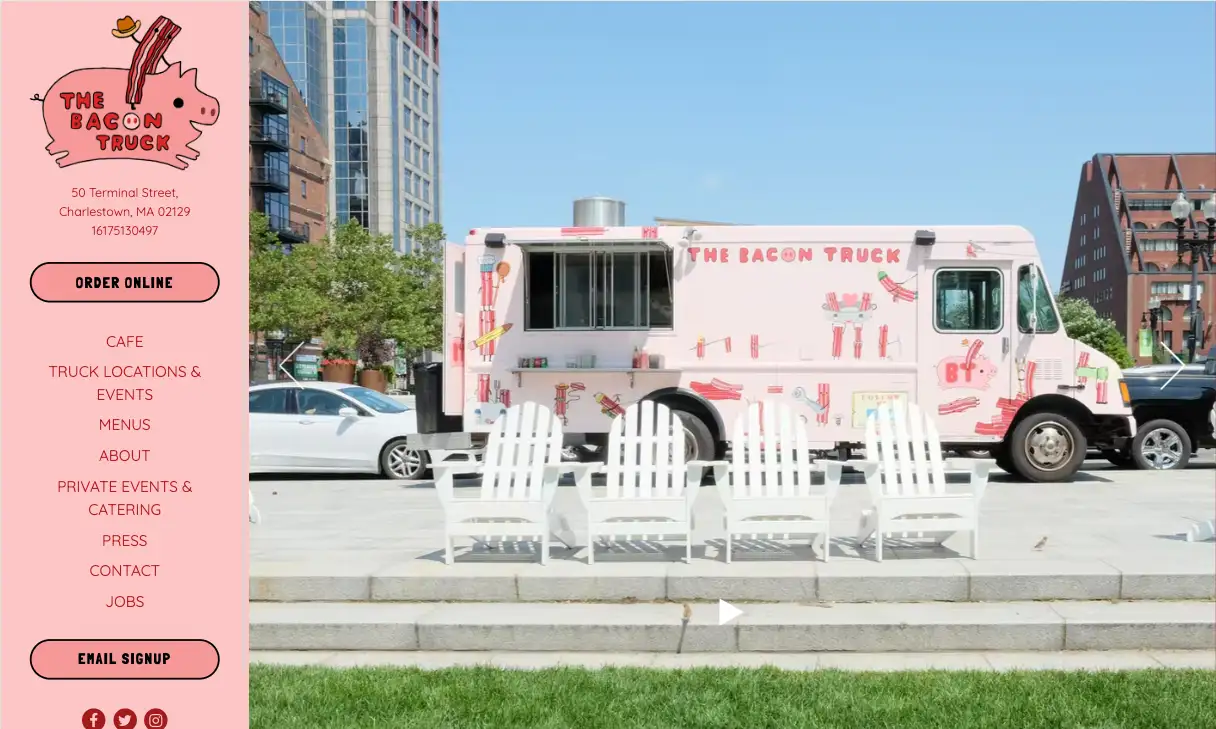
The Bacon Truck’s website works on every level. As soon as the page loads, visitors are greeted with a carousel of images of the food truck’s design and the food it serves, enticing them to learn more or order. The design is meticulously on-brand — and fittingly pink to match with its porky mascot.
More than that, The Bacon Truck's website promotes all of its trucks and locations, including brick-and-mortar stores. Its most important calls-to-action are clear so that visitors can see where the truck is located, sign up for the email list and order directly through the website. Other links point to whatever someone on the website might need: menus, social media pages, careers and even catering info.
Best Practice: Promote and Accept Private Event Inquiries
If you're running a food truck, you're likely counting on large catering orders and private events to drive revenue. While some guests may be willing to send an email or call a phone number, many guests prefer — or require — the ability to submit inquiries online. To meet that demand, your website should have a landing page that details how these arrangements work and captures private inquiries with restaurant event software. This is another thing The Bacon Truck's website does well.

RESOURCE
12 Must-Haves for Restaurant Websites
Take your digital front of house to the next level.
2. Re-Engage Diners With Email Marketing
If your website has direct online ordering or direct online catering, you'll start to capture more than sales. You'll also capture email addresses, which are one of the most valuable commodities in restaurant marketing. The ability to own this data, rather than allowing third-party marketplaces to own it, is a major benefit to direct ordering. Food trucks can use email marketing to re-engage past diners and increase the lifetime value of each customer.
Example: Boxcar Burgers
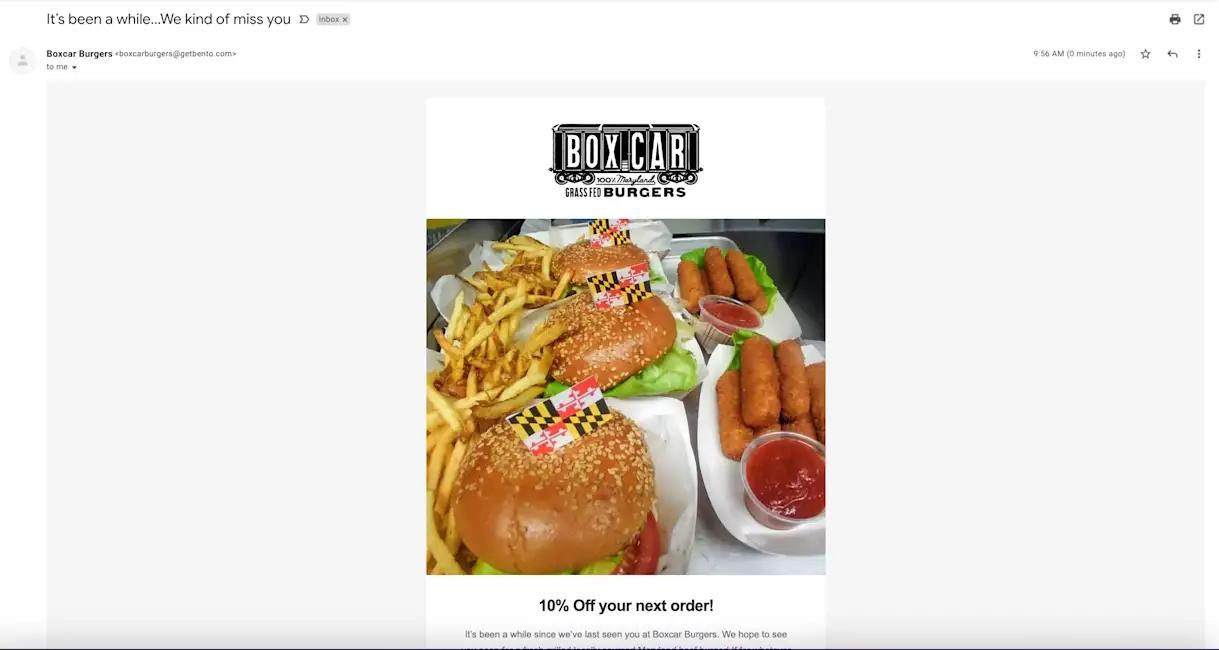
Boxcar Burgers, a food truck in Maryland, sends emails to thousands of customers after they order. With BentoBox Automated Marketing Campaigns, it automatically sends a "welcome email" to new diners and a 10% promo code to lapsed diners who haven't ordered for 30 days.
The "it's been 30 days" email in particular is a revenue-driver. The email template captures attention with authentic photography, then uses bold text to make the 10% off discount hard to miss. Everyone who receives this email has gone 30 days without ordering — but despite that, nearly half of diners who receive this email open it. Another BentoBox customer, Dough Artisan Pizza, drives $96 in revenue every time a customer clicks on its $5 off email. That's how powerful email marketing can be.
Best Practice: Use Automated Email Software
Creating an email strategy, manually segmenting email lists and sending timely emails takes time that food truck operators don't have. Automated email software allows them to set up the strategy once, then have their website do all the work that follows. The website will log the date of the customer's first order, then send promotions and discounts based on how long it's been since that date. As the restaurant industry staffing shortage continues, efficient solutions like this become even more essential.
3. Promote Upcoming Appearances on Social Media
Diners follow restaurants to see not only food pics, but also to see if the restaurant has any upcoming deals or events. That second point is arguably most important for food trucks, which operate — by nature — at a different open market, concert or brewery every time they open up shop. Promoting upcoming service at these venues helps generate buzz and get more people interested in not just the truck’s food, but where they’ll be able to eat it.
Example: Disco Cheetah
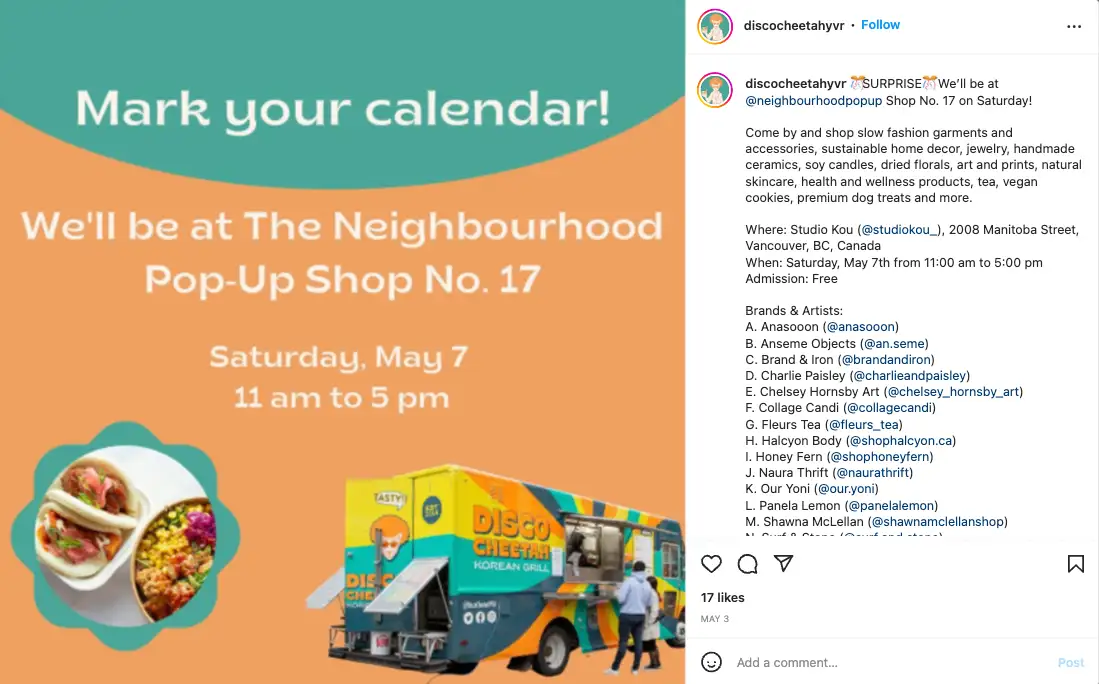
Disco Cheetah’s Instagram profile is filled with essential content like videos, food pics and shots of happy customers. However, what’s really eye-catching is the branded template it uses to announce upcoming venues, as seen in the example above. There’s a clear call-to-action telling followers to mark their calendars. The description also calls out what people can expect from the event, plus when and where it's happening. Designing templates like this, then adjusting them for every new event, is a simple and easy way to spread the word on followers’ social media feeds.
Best Practice: Follow the 80/20 Rule
If a food truck’s entire social media profile is announcements of upcoming venues, it will struggle to grow a large, engaged following. After all, if someone wants to see an events calendar, they can simply check the food truck’s website. To keep follower numbers high, but also not miss out on exposure, follow the 80/20 rule of social media posting. This means that 80% of content should be entertaining (eye-catching food visuals, videos of happy customers, etc.), while 20% should promote upcoming venues and other aspects of the truck.

RESOURCE
25 Creative Restaurant Instagram Ideas
Inspiration from the largest restaurant social accounts, with advice on how to apply it to your own strategy.
4. Create Short, Vertical Social Media Videos
On social media, videos work even better than static images. This has been true for several years now, but the trend is actually growing in size and scope. Short, vertical videos in particular have become the predominant way many internet users consume content. The historically fast rise of TikTok, which was built on these videos, is a testament to this idea.
While videos can be published as regular posts on Facebook, Instagram and TikTok, they can also be made as Stories on Facebook, Instagram and Snapchat. With a 24-hour lifespan, Stories are perfect for publishing videos "day of" videos from the food truck's venue, including the lines of guests and a look at what’s cooking to stir up more hype.
Example: Soulfly Chicken
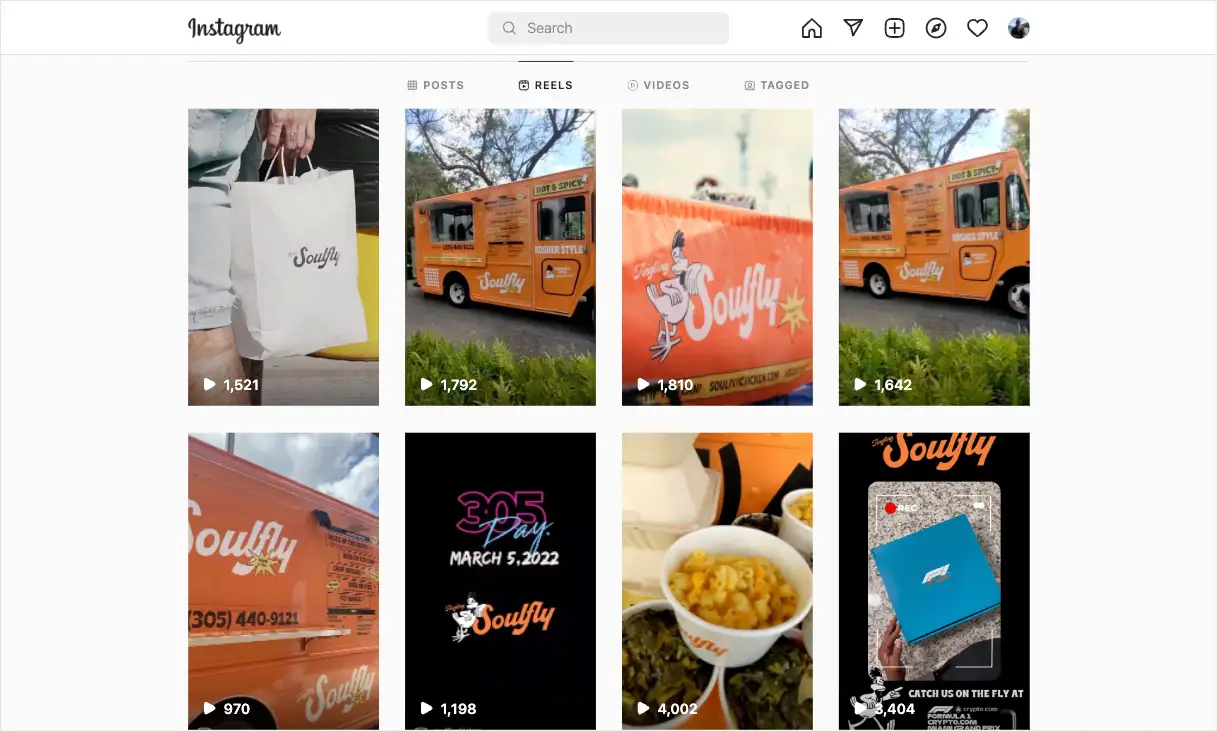
Soulfly Chicken uploads frequent Instagram Reels, which are essentially Instagram's version of short, vertical, TikTok-style videos. These posts appear in the News Feed but also get housed in the "Reels" tab on Soulfly's page.
Soulfly's Instagram videos accomplish a lot in a short span of time. For example, this video covers one of its daily events with quick shots of its truck design, comfort food fix-ins and customers grabbing food to go. It promotes every aspect of the event in a single Instagram Reel, along with details of where and when the event is occurring. This shows fans and followers so much more than a static image of chicken wings.
Best Practice: Emphasize the First Three Seconds
Video drop-off rates are real. If you don't command a user's attention quickly, they can — and will — scroll to the next piece of content. Because of this, the first three seconds of your video should contain your most "thumb-stopping" footage. Don't save your big dish reveal for the end of a 15-second video; preview it at the beginning, and then show how it all comes together.
Read more: How to Use TikTok for Restaurant Marketing
5. Use Sticky, Memorable Brand Elements
Food trucks face the threat of being fleeting, as they often have no set location and can struggle with long-term recognition. That’s why it’s crucial to nail down and emphasize the food truck’s brand at every interaction with diners. This includes making a unique food truck logo (and putting it on restaurant packaging), as well as selling restaurant merchandise for a lasting impression. You don't want to be "that awesome food truck we ate from at the brewery last weekend." If the food was memorable, your brand should be remembered.
Example: Moyzilla

Moyzilla is known in the Boston area for its logo, which features a dumpling-hungry giant lizard. The image is iconic because it’s prominently featured on Moyzilla's truck, but also because it’s used heavily in other promotional material. In the Instagram post above, for example, the mascot is holding bubble tea, highlighting its availability for the summer season. Disco Cheetah doesn't use its mascot in quite the same way, but it still creates and highlights sticky brand elements. The first thing guests see on its website is the groovy, multicolored spiral design from its food truck. This helps build brand cohesion and makes guests more likely to notice the truck in the wild.
Best Practice: Promote and Sell Merch Online
Even if diners don’t spring for a t-shirt or bottle of signature sauce the day they visit, they may in the future. Holidays, birthdays and other big occasions also encourage people to brainstorm ideas for gifts and buy them online. If you're investing in your brand and selling restaurant merchandise, promoting it online is a no-brainer. The global rise of e-commerce has made people extremely comfortable buying goods on the internet; as long as you make the checkout experience easy for them, there's value in driving people to those pages.
Get Started with Food Truck Marketing
Food trucks face unique challenges and opportunities that their brick-and-mortar counterparts don’t, which means they face a unique marketing landscape.
Mastering social media, communicating the truck’s venue calendar and expanding into catering are just a few ways to keep a food truck on a road to success — and it all ties back to a food truck’s website.
A website links out to social media pages, specifies where the truck can be found and makes ordering food, catering and merchandise simple. If you haven’t already, learn more about how the BentoBox Marketing & Commerce Platform can help a food truck thrive.

BentoBox Marketing & Commerce Platform
Want to stand out online? Let's chat.
Drive revenue directly through your website.
Recommended

Marketing
A Beginner’s Guide to Facebook Ads for Restaurants
January 8, 2024
Intimidated by the world of Facebook advertising? Here’s a step-by-step guide for setting up your ads with real restaurant examples.

Marketing
Online Advertising Tools & Tips for Restaurants
April 30, 2019
A breakdown on Facebook, Instagram and Google Ads
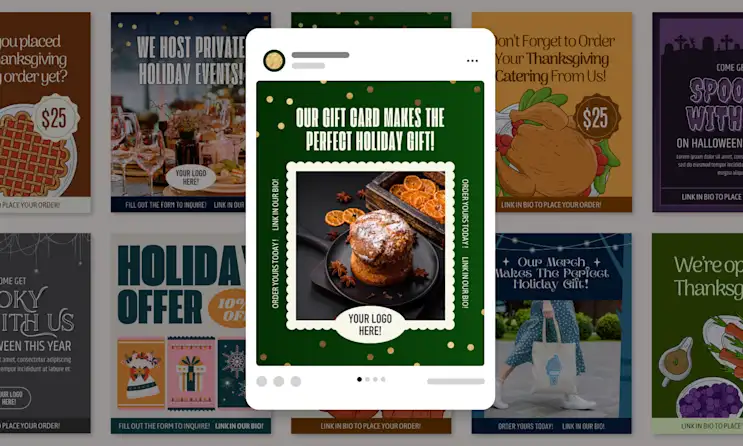
Holidays
15 Digital Marketing Holiday Templates for Restaurants
September 18, 2024
Give your holiday marketing some extra special treatment with one of the following templates.

